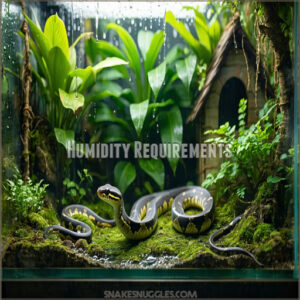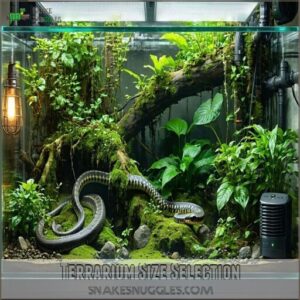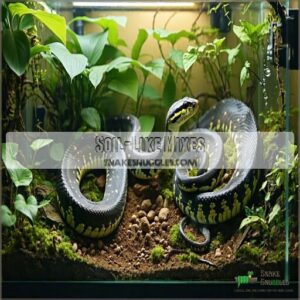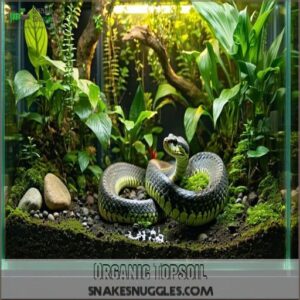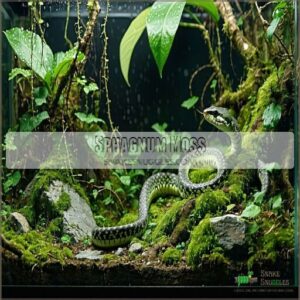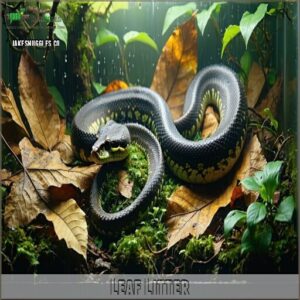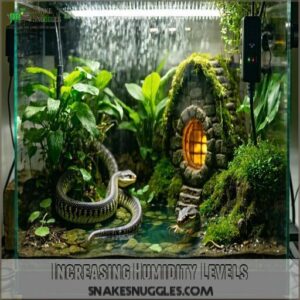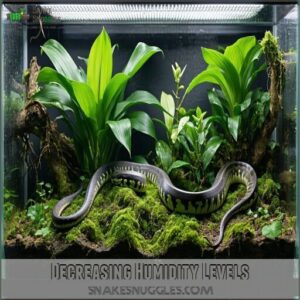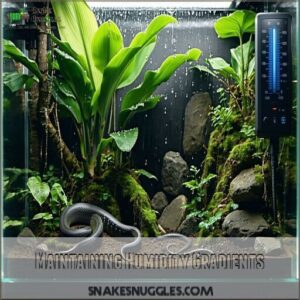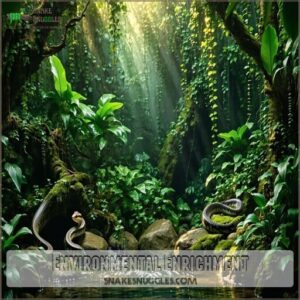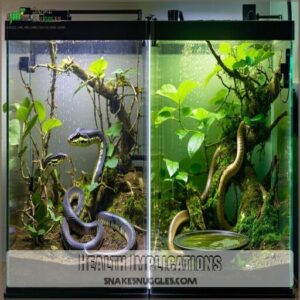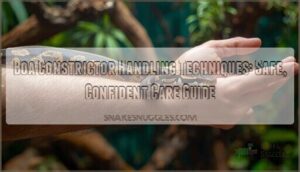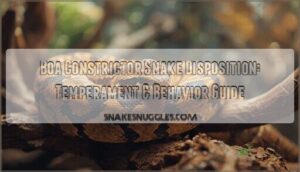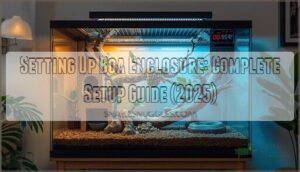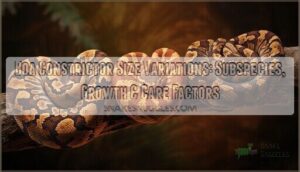This site is supported by our readers. We may earn a commission, at no cost to you, if you purchase through links.
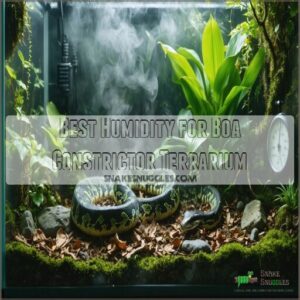 You’ll want to nail the best humidity for boa constrictor terrarium, which is between 60-70%.
You’ll want to nail the best humidity for boa constrictor terrarium, which is between 60-70%.
Lower humidity can lead to dehydration and shedding problems, while higher humidity risks respiratory infections. Use a hygrometer to monitor levels.
A damp substrate, like cypress mulch, can help maintain humidity. Regular misting can boost humidity, but avoid soaking the enclosure. Proper ventilation is key to prevent mold growth.
There’s more to discover about creating the perfect environment for your boa.
Table Of Contents
- Key Takeaways
- Humidity Requirements
- Terrarium Size Selection
- Substrate Options
- Humidity Maintenance
- Environmental Enrichment
- Health Implications
- Frequently Asked Questions (FAQs)
- How much humidity does a boa constrictor need?
- How much soil do you need for a boa constrictor?
- What temperature should a boa constrictor be at?
- How to care for Boa constrictors?
- Do boa constrictors need a hygrometer?
- How much humidity does a boa need?
- What humidity should a Boa enclosure be?
- What temperature should a Boa terrarium be kept at?
- What humidity should a snake enclosure be?
- What if humidity is too high for snake?
- Conclusion
Key Takeaways
- You’ll want to maintain the best humidity for your boa constrictor’s terrarium, which is between 55-75%, to ensure their health and comfort, and you can achieve this by using a hygrometer to monitor levels and adjusting as needed.
- To create a humid environment, you can use a damp substrate like cypress mulch, and regular misting can also help boost humidity, but be sure to avoid soaking the enclosure and provide proper ventilation to prevent mold growth.
- It’s essential to maintain a temperature gradient of 75-90°F, with a basking spot of 90°F and a cooler area around 75-80°F, and you should also provide a spacious enclosure with hides, climbing structures, and a water bowl to keep your boa happy and healthy.
- You should aim to keep the humidity levels consistent, but with occasional fluctuations to mimic natural environments, and be prepared to adjust the humidity levels during shedding, when your boa may need higher humidity levels, typically between 75-85%, to ensure a successful shed.
Humidity Requirements
You need to maintain the right humidity levels for your boa constrictor’s terrarium, as it directly affects their health and comfort.
You’ll want to keep the humidity between 55-75%, which is the best range for boa constrictors, and monitor it regularly to make sure your pet stays healthy.
Optimal Humidity Range
You’ll want to maintain ideal humidity levels between 55-75% for your boa constrictor’s terrarium, with occasional increases to 75-85% during shedding, to create a proper environment, sustaining humid microclimates and an ideal humidity range for your pet’s health.
To achieve the right environment, monitor the humidity measurement techniques to sustain a healthy boa constrictor, focusing on proper environment and healthy boa constrictor.
Humidity Measurement Tools
You’ll need tools like Digital Hygrometers or Humidity Sensors to measure humidity levels accurately.
A digital hygrometer is best, providing precise readings.
You can buy a digital hygrometer terrarium.
Calibration Tools guarantee accuracy.
These devices help you monitor and adjust humidity levels, essential for your boa’s health.
They measure humidity levels effectively, using tools like Humidity Sensors.
Importance of Humidity Monitoring
Accurate humidity monitoring devices are key to a thriving boa habitat. Knowing your terrarium humidity levels helps avoid issues like dehydration and respiratory problems. Regular checks with a digital hygrometer maintain ideal boa humidity.
Providing a proper terrarium setup is also essential. This lets you fine-tune moisture control and understand how temperature effects humidity. Think of it as managing your boa’s mini-rainforest!
- Healthier snake
- Easier shedding
- No more guesswork
Terrarium Size Selection
You’ll need to pick the right size terrarium for your boa so it has enough room to stretch out and explore.
Make sure it’s big enough for your snake to thrive as it grows.
Measuring Snake Length
Accurate measurements of your boa constrictor’s length are key to sizing its terrarium.
Use a flexible tape measure to get the snake’s full length, from the tip of its nose to the end of its tail.
Do this a few times to get an average, as they can stretch out or curl up, affecting the reading.
This simple step makes sure your boa has the right space to thrive.
Calculating Floor Space
To calculate the ideal floor space for your boa constrictor’s terrarium, a simple formula is: enclosure length x width.
For example, a 4’x2′ enclosure provides 8 square feet of floor area.
This spacious setup provides your boa has ample room to move and grow, promoting a healthy, active lifestyle, and a minimum enclosure size.
Remember, the minimum enclosure size should be equal to or greater than the expected adult length of your snake.
Considering Vertical Space
When planning your boa constrictor’s enclosure, don’t forget about vertical space. Boas are semi-arboreal, meaning they like to climb and explore at different heights.
Here are some tips for maximizing vertical space:
- Provide climbing structures, such as branches or ledges.
- Verify structures are secure and can bear your snake’s weight.
- Place branches strategically to encourage exploration.
- Create a bioactive terrarium with plants for cover and elevation.
- Use vertical space to increase the overall size of the enclosure without taking up more floor space.
Understanding terrarium size requirements is essential for creating an ideal environment for your boa constrictor.
Substrate Options
You’ll need the right mix of materials in your boa’s terrarium to keep the humidity just right, and a blend of organic topsoil, sphagnum moss, and leaf litter works best.
This blend creates the perfect moisture-holding substrate by layering these materials at least 4 inches deep, which will help maintain humidity between 55-75%.
Soil-Like Mixes
Your boa’s comfort starts with the right soil mix. A blend of 40% plain topsoil, 40% ReptiSoil, and 20% play sand creates an ideal burrowing substrate that holds moisture perfectly.
For those seeking pre-mixed options, consider ReptiSoil products.
For better humidity control, try adding coco coir and sphagnum moss to your mix. You can also opt for ready-made options like Terra Firma, which supports tunneling and maintains proper humidity levels.
Organic Topsoil
Organic topsoil forms the foundation of your boa constrictor’s substrate, creating a natural environment that maintains ideal humidity levels.
For the best results in your bioactive terrarium, choose chemical-free topsoil with these essential qualities:
- Rich in organic matter for moisture retention
- Free from pesticides and fertilizers
- Well-draining to prevent waterlogging
- Dark in color, indicating good decomposition
- Slightly acidic pH between 6.0-7.0
When selecting a substrate, understanding burrowing behavior is essential for creating a thriving environment.
Sphagnum Moss
Sphagnum Moss is a soft, absorbent moss that holds water well.
It’s a great option for creating a humid environment for your boa.
Mix it with other substrates like coconut coir and sand to retain water and provide a naturalistic environment.
You can place it under hides, along the sides of the enclosure, or mix it throughout.
Maintain moisture levels with regular misting.
This moss is a natural choice for boa enclosures.
For best results, consider using high quality moss substrate products to enhance the overall habitat.
Leaf Litter
Leaf litter is an important component of a bioactive terrarium, mimicking forest floors and providing a naturalistic substrate for your boa.
It helps maintain reptile humidity by creating humid microclimates.
Here’s what you need to know:
- Leaf Depth: Aim for a leaf depth of 1-2 inches. This provides sufficient coverage without impeding your boa’s movement.
- Litter Types: Use a mix of dried leaves, such as oak, maple, and magnolia. Make sure they’re free of pesticides.
- Moisture Levels: Spray the leaf litter with water to maintain moisture, replicating the natural environment and supporting the growth of beneficial microorganisms.
Humidity Maintenance
Maintaining the right humidity level for your boa constrictor is essential for its health and comfort.
You’ll need to learn how to increase or decrease humidity and create a healthy humidity gradient in your snake’s terrarium to ensure its overall comfort.
Increasing Humidity Levels
To boost humidity levels in your boa constrictor’s terrarium, try these methods:
| Method | Description |
|---|---|
| Water Bowls | Place a large water bowl under the heat source to encourage your snake to soak. |
| Misting | Use a spray bottle to mist the enclosure with water regularly. |
| Foggers | Invest in a cool mist fogger to simulate natural fog and increase ambient humidity. |
| Substrate Moisture | Mix water into the substrate to mimic natural humidity cycles. |
| Humid Hides | Create a hideout with damp sphagnum moss for a humid retreat. |
Maintaining essential humidity is key, and understanding humidity control methods will help you create a healthy environment.
These techniques will help you achieve and maintain the ideal boa constrictor humidity range of 55-75%, which is crucial for your snake’s well-being, and by following these humidity control methods, you can ensure a thriving habitat.
Decreasing Humidity Levels
Sometimes, less is more, and that’s especially true regarding humidity for your boa.
If you notice excessive fog in the terrarium, it’s time to take action. First, reduce the water bowl size or move it to a cooler spot.
Next, boost ventilation by exposing more mesh or drilling holes. Different substrates, like orchid bark or moss, can also help.
And if all else fails, a dehumidifier will do the trick.
Maintaining Humidity Gradients
Fluctuating humidity levels are ideal for your boa’s terrarium.
Aim for a range between 55-75% with occasional spikes during shedding.
Avoid a constantly damp environment to prevent mold and mildew.
Use a digital hygrometer to monitor levels.
Mimic natural humidity cycles by mixing water into the substrate.
Automated foggers and misting systems can help maintain humidity, but make certain proper drainage to avoid excess moisture.
Environmental Enrichment
Creating an enriching environment for your boa constrictor involves more than just maintaining the right humidity.
It’s about adding hides, climbing structures, and rearranging decorations to encourage exploration and provide a stimulating space for your pet snake.
Adding Hides and Climbing Structures
Creating a comfortable and enriching environment for your boa constrictor involves more than just maintaining the right temperature and humidity levels.
You want your pet to feel right at home, so it’s time to get creative with hides and climbing structures.
Here are some key tips:
- Hide Placement: Position at least two hides in the enclosure, one on the warm side and another on the cool side.
- Climbing Ramps: Boas are semi-arboreal, so include ramps or branches for climbing.
- Branch Types: Opt for naturalistic branches, such as grapevine or manzanita, to provide a naturalistic feel and offer varying levels of challenge for your snake.
- Snake Ledges: Install ledges or shelves at different heights to create a multi-level environment, encouraging exploration and exercise.
- Decor Options: Use artificial foliage and other decor to create a visually appealing and stimulating habitat.
Creating Humid Hides
Creating a cozy and humid hide is a great way to make sure your boa stays healthy and happy.
Line a reptile hide with damp sphagnum moss and place it on the cool end of their enclosure. This provides a nice, misty retreat for your snake to relax in.
You can also increase humidity by using a larger water bowl or placing it near a heat source. Just be sure to monitor the humidity levels with a digital hygrometer to make sure they stay in the ideal range for your boa’s health, and maintain a cool end of the enclosure for a misty retreat.
Rearranging Decorations
Keeping your boa constrictor entertained and engaged is essential for their well-being.
Regularly mix up the layout of their terrarium to create a stimulating environment.
This decor refresh provides your snake with a sense of novelty and encourages exploration.
It’s like giving them a new playground to explore, promoting physical activity and mental stimulation.
Don’t forget to take into account visual barriers and climbing structures when rearranging, ensuring a balanced environment.
Health Implications
Maintaining the right humidity levels in your boa constrictor’s terrarium is critical for their health.
Dehydration, respiratory issues, and shedding problems can occur if humidity is too low, while excessive moisture can lead to scale rot and other health concerns, making proper humidity control essential.
Dehydration Prevention
Make sure the water bowl is big enough for your snake to soak in, and place it near the heat source to encourage hydration.
Monitor moisture levels with a digital hygrometer, and keep the substrate damp.
Signs of dehydration include dry skin and your boa spending a lot of time in the water bowl, which can lead to serious health problems, so maintaining proper boa humidity is key.
Respiratory Infection Prevention
You don’t want your pet snake to get sick, so watch out for these signs of respiratory infection:
- Your boa seems tired and isn’t eating much.
- Their eyes look sunken, and their skin might be discolored.
- They’re having trouble with pooping, and you hear weird noises when they breathe.
If you spot any of these, get them to a vet ASAP.
To prevent infections:
- Keep the humidity up (55-75% is ideal).
- Make sure their temps are just right.
- Keep their food and water clean.
- Use antibiotics if needed.
Importance of UVB Lighting
UVB lighting plays a significant role in maintaining your boa’s health.
It’s like giving your snake a daily dose of sunshine, which is essential for strong bones and a healthy immune system.
Aim for a basking spot of around 90°F, with a 12-hour lighting cycle, including a period of darkness at night.
This photo period mimics your boa’s natural environment, ensuring they get enough Vitamin D.
A UVB lamp is an easy way to provide this essential light.
Frequently Asked Questions (FAQs)
How much humidity does a boa constrictor need?
Your boa constrictor needs 50-70% humidity regularly. During shedding, aim for 75-85%. A digital hygrometer will help you keep it just right.
How much soil do you need for a boa constrictor?
You’ll need a soil-like substrate mix for your boa constrictor’s terrarium.
This mix should include organic topsoil, sphagnum moss, and leaf litter.
Aim for a depth of at least 4 inches to maintain the right humidity levels.
What temperature should a boa constrictor be at?
Your boa constrictor’s temperature needs to be just right—not too hot, not too cold.
Imagine Goldilocks setting up her terrarium.
Aim for 86–90 °F in the warm hide and 75–80 °F in the cool hide.
How to care for Boa constrictors?
Caring for boa constrictors involves creating a comfortable habitat with the right temperature, humidity, and lighting.
Provide a spacious enclosure with hides, climbing structures, and a water bowl.
Maintain a balanced diet of frozen-thawed rodents, and practice gentle handling.
Do boa constrictors need a hygrometer?
Yes, you need a hygrometer to monitor humidity levels in your boa constrictor’s terrarium. This tool guarantees your snake’s environment stays comfy and healthy, like a thermostat for humidity control.
How much humidity does a boa need?
You’ll want to maintain humidity levels between 55-75% for your boa constrictor, with occasional fluctuations to mimic natural environments and prevent health issues.
What humidity should a Boa enclosure be?
You should maintain a humidity level of 55-75% in your Boa’s enclosure, with occasional fluctuations, to mimic their natural habitat and support overall health.
What temperature should a Boa terrarium be kept at?
You should keep your Boa’s terrarium at a temperature gradient of 75-90°F, with a basking spot of 90°F and a cooler area around 75-80°F for ideal health.
What humidity should a snake enclosure be?
You’ll aim for 55-75% humidity in your snake enclosure, with occasional fluctuations, to mimic its natural habitat and prevent dehydration.
What if humidity is too high for snake?
You’ll need to reduce humidity if it’s too high, as excessive moisture can cause scale rot, by increasing ventilation or using a dehumidifier to prevent health issues.
Conclusion
Now you’ve learned about creating a perfect environment for your boa.
For example, a boa owner maintained the best humidity for boa constrictor terrarium, between 60-70%, and saw improved health.
You’ll achieve this by monitoring, maintaining, and adjusting the best humidity for boa constrictor terrarium to secure your pet’s well-being.
- https://reptifiles.com/boa-constrictor-care/boa-constrictor-humidity/
- https://dubiaroaches.com/blogs/snake-care/boa-constrictor-care-sheet
- https://reptilerapture.net/boa-constrictor-caresheet.html
- https://www.justanswer.com/pet-reptile/o6flb-think-juvenile-boa-constrictor-respiratory.html
- https://www.inaturalist.org/observations?taxon_id=32092

